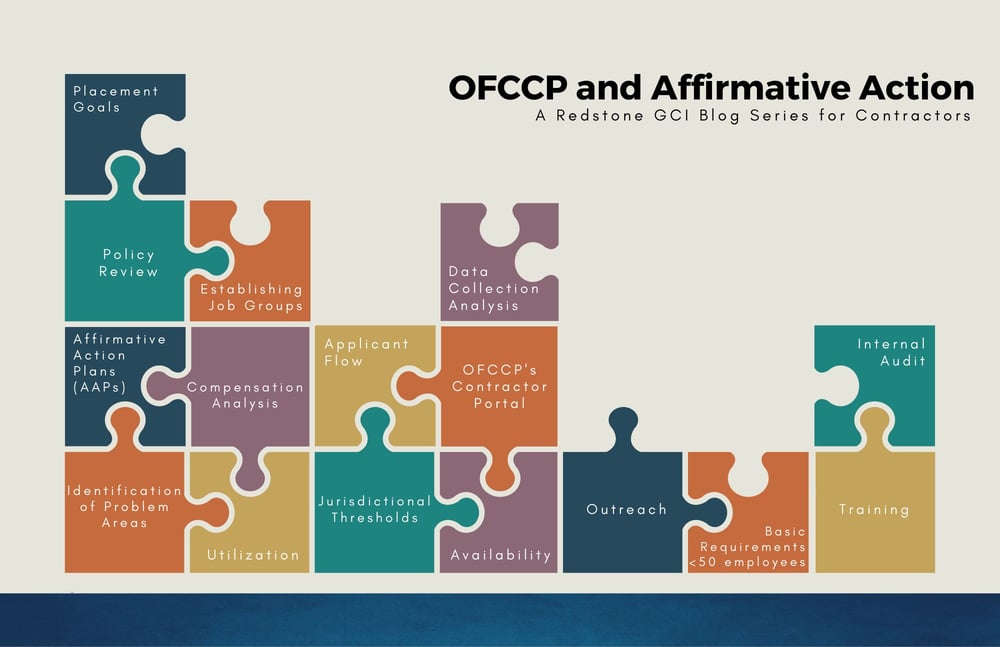
This article is under review as a result of EO 14173, Ending Illegal Discrimination and Restoring Merit-Based Opportunity, signed by President Trump on January 21, 2025. As we await further information from OFCCP and the courts, please reference this article for current status and action items.
We hope that the previous blogs have provided a solid explanation as to what an Affirmative Program is and who the Office of Federal Contract Compliance Programs (OFCCP) is. The requirement to maintain a written plan/s and ensure all action items noted within the plan are being executed can be a daunting task. As we begin to steer away from the basics of what the various requirements and components of a written plan are, we will begin to dive into helpful tips and best practices. As shown in the diagram from a previous blog in this series, the establishment of Job Groups and Activity records are critical to establishing a valid Affirmative Action Plan and are therefore worth focusing on.
Job Groups
Job Groups are the basis for the Utilization and Adverse Impact Analysis of each Establishment.[1] This analysis is the “meat” of the plan and is essential information to be considered when auditing internal processes and initiating outreach efforts; thus, the Job Groups are an integral component of the plan development. Job Groups are different from EEO-1 categories; however, a contractor may use the established EEO-1 categories as Job Groups if there are fewer than 150 employees in the workforce. As a reminder, the EEO-1 Categories are:
- Executive/Senior Level Officials and Managers
- First/Mid-Level Officials and Managers
- Professionals
- Technicians
- Sales Workers
- Administrative Support Workers
- Craft Workers
- Operatives
- Laborers and Helpers
- Service Workers
If a contractor has more than 150 employees, these EEO-1 categories need to be sub-divided. In order to provide a more accurate representation of your workforce and related analysis, we often suggest dividing EEO-1 categories into different Job Groups prior to reaching 150 employees. The following factors must be considered when establishing Job Groups:
- Similar duties and responsibilities
- Similar rates of pay
- Similar opportunities, to include training, transfer, promotion and benefits
It is not necessary to sub-divide all EEO-1 categories. Instead, consider the diversity of roles, pay and opportunities within each. Though OFCCP does not provide a minimum number of incumbents within a Job Group which they specify is acceptable, it is important to maintain Job Groups with enough incumbents to provide meaningful analysis.
As an example, the EEO-1 category of 2-Professionals often encompasses a vast array of positions with greatly varying responsibilities, pay and opportunities; therefore, this is often one of the first groups that should be sub-divided. In this case, Job Groups such as these may be appropriate:
- 2A Administrative Professionals (i.e., Human Resources, Accounting, and Contracts professionals)
- 2B Analysts (i.e., Systems and Business Analysts)
- 2C Engineers (i.e., Software, Electrical, Aerospace Engineers)
The availability of candidates by race and gender in these groups may vary significantly, thus allowing for your data to provide a more accurate representation of current utilization and appropriate goals. This process should be approached carefully and strategically as it may be necessary to explain and justify the creation of these Job Groups to OFCCP if audited.
Activity
All records pertaining to all employment-related activities are vital to creating a valid Affirmative Active Plan and thus implementing a meaningful Affirmative Action Program. These records are the driver behind the requirement of “Identification of Problem Areas,” which we will address in greater detail in a later blog in this series. Accurate records of all activity, to include recruitment, applicant flow, hires, transfers, promotions, training, compensation, and even benefit policies may be reviewed if audited. Some of the following activities are used to develop the Plan:
- Applicant Flow
- Hires
- Termination
- Promotions
What’s Next in This Series?
We find that the most challenging activity to accurately capture is the Applicant Flow. What data must be maintained? Who is an internet applicant? Where was this applicant sourced from? Did you capture self-ID forms for each applicant? If unable to answer all of these questions, you aren’t alone! Many contractors struggle to effectively recruit and hire while also complying with the various requirements related to applicant tracking. Next in this series, we will answer these questions as well as address some of the more common flaws and fixes to Applicant Flow.
[1] Reference 41 CFR 60 2.1(d) for information on Establishments and how to determine which affirmative action program each employee should be included in.


 Sheri joined Redstone Government Consulting, Inc. in December 2012 as a Human Resources Consultant. She provides HR consulting services to our customers on a wide range of issues, from specific projects to an ongoing outsourced solution of the human resources function. Sheri has two decades of experience in providing a comprehensive assessment of all areas of HR, including establishing and implementing policies and practices, contract transition efforts/onboarding, and investigations. Sheri’s experience covers a broad spectrum of compensation planning and analysis for total compensation projects, reasonableness assessments including executive compensation, compensation philosophy development, total reward strategies, benefits analysis, market pay and pay equity evaluations. She regularly supports clients with the analysis and mapping of labor categories and the preparation and analysis of wage calculations and supports clients in pricing disputes with DCAA. Sheri has a wealth of experience in navigating the many compliance challenges associated with Service Contract Act and Davis Bacon Act. She has been a valuable resource to our clients in all these areas. She stays abreast of the various requirements of the Department of Labor and, of great importance to government contractors, the Office of Federal Contract Compliance Programs, as well as other federal and state regulations impacting human resources. Professional Experience Prior to joining Redstone Government Consulting, Inc., Sheri served in various roles in the Human Resources arena. While employed by a mid-size government contractor she assisted with database development, recruiting, affirmative action planning and contract proposals. Sheri later became an Employment Specialist with one of the largest employers in Huntsville, where she assisted and led managers in the interpretation and documentation of the progressive disciplinary process, conducted employee investigations and allegations of discrimination, sexual harassment, wrongful discharge and employee disputes, conducted unemployment hearings and conducted new employee orientation. Sheri developed and presented management training, administered facility compensation plan, monitored staffing budgets and wrote job descriptions and handbook revisions.
Sheri joined Redstone Government Consulting, Inc. in December 2012 as a Human Resources Consultant. She provides HR consulting services to our customers on a wide range of issues, from specific projects to an ongoing outsourced solution of the human resources function. Sheri has two decades of experience in providing a comprehensive assessment of all areas of HR, including establishing and implementing policies and practices, contract transition efforts/onboarding, and investigations. Sheri’s experience covers a broad spectrum of compensation planning and analysis for total compensation projects, reasonableness assessments including executive compensation, compensation philosophy development, total reward strategies, benefits analysis, market pay and pay equity evaluations. She regularly supports clients with the analysis and mapping of labor categories and the preparation and analysis of wage calculations and supports clients in pricing disputes with DCAA. Sheri has a wealth of experience in navigating the many compliance challenges associated with Service Contract Act and Davis Bacon Act. She has been a valuable resource to our clients in all these areas. She stays abreast of the various requirements of the Department of Labor and, of great importance to government contractors, the Office of Federal Contract Compliance Programs, as well as other federal and state regulations impacting human resources. Professional Experience Prior to joining Redstone Government Consulting, Inc., Sheri served in various roles in the Human Resources arena. While employed by a mid-size government contractor she assisted with database development, recruiting, affirmative action planning and contract proposals. Sheri later became an Employment Specialist with one of the largest employers in Huntsville, where she assisted and led managers in the interpretation and documentation of the progressive disciplinary process, conducted employee investigations and allegations of discrimination, sexual harassment, wrongful discharge and employee disputes, conducted unemployment hearings and conducted new employee orientation. Sheri developed and presented management training, administered facility compensation plan, monitored staffing budgets and wrote job descriptions and handbook revisions.